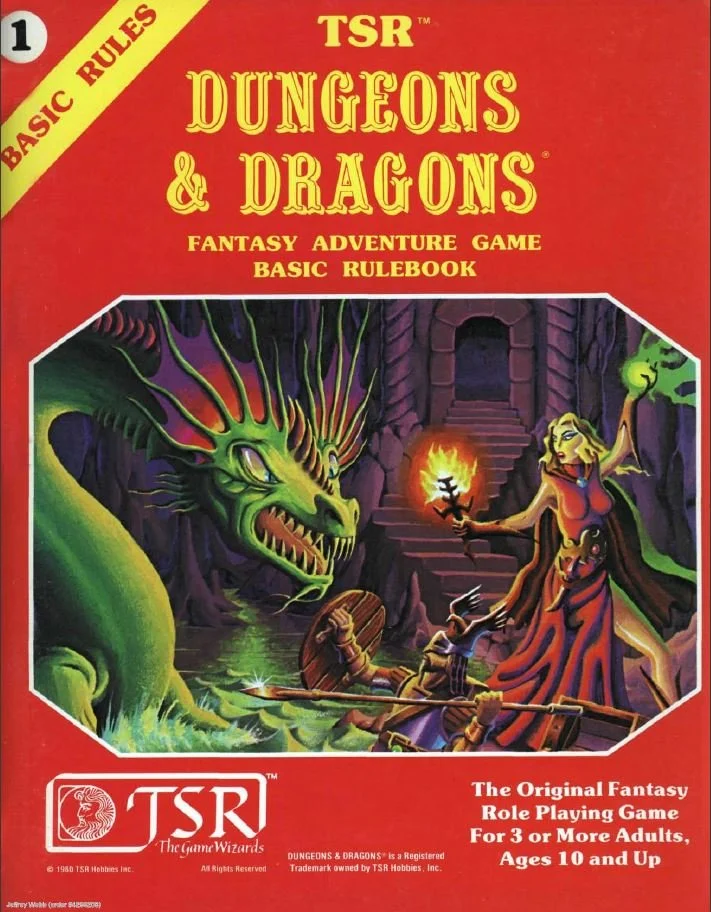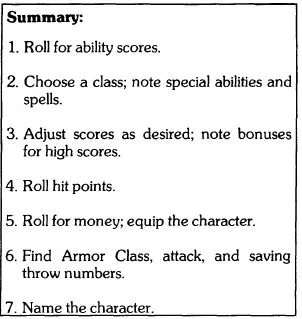CHARACTER CREATION CHALLENGE 2023: B/X D&D (1 of 6)
THE GAME: Dungeons & Dragons Basic Set (1981)
The original 1974 rules were expanded upon by the supplements that followed, leading to the classic quartet of Cleric, Fighter, Magic-User, and Thief by the release of the Dr. J. Eric Holmes Basic Set in 1977. Tom Moldvay’s 1981 revisit of that set added some iconic D&D-isms to the mix that many players of a certain age still find endearing today. Among those features is “race-as-class” in which the demihuman characters are considered to be classes in and of themselves, sort of paragons of what it is to be a stereotypical Dwarf, Elf, and Halfling in the implied D&D world. Another feature is that Basic D&D now led into Expert D&D, not the Advanced D&D game. “Basic D&D” became its own product line, separate from AD&D, and it evolved in its own way from the Expert Set by Zeb Cook and Steve Marsh, and then into the Basic-Expert-Companion-Master-Immortals (BECMI) edition edited by Frank Mentzer. BECMI and its cover art might be more immediately recognizable to people outside the hobby - certainly it’s appeared recently on everything from pillowcases and throw blankets to t-shirts. Within this first Expert Set Cook and Marsh introduced “The Known World” - which then was expanded into the Gazetteer series, and then into the sadly unfinished Mystara setting for AD&D.
All that said, this, arguably, is where the amazing legacy of “basic” D&D really took off as a separate entity from AD&D, with its own product identity and decade-and-a-half run. I recall a lot of older gamers looking down on the boxed sets as not being as mature as the hardcover AD&D game. For my money, however, D&D (no bloody “A”) was a complete game in and of itself, and offered a cleanliness and simplicity AD&D did not while slowly expanding to cover things evern AD&D didn’t - like domain management and mass combat in the BECMI sets, both of which required additional products outside the core book in AD&D. In recent years, interest in the basic D&D line has begun to refocus on the Moldvay/Cook/Marsh Basic/Expert edition. This isn’t to say the more expansive BECMI line isn’t beloved, and the capstone Rules Cyclopedia by Aaron Allston remains my “Desert Island” D&D book as a single-volume treatment of D&D, but the tighter, tops-out-at-Level 14 design of B/X has drawn a lot of attention and nostalgia. Necrotic Gnome’s amazingly done Old School Essentials line not only presents B/X in a cleaned-up, two-volume hardcover edition but goes on to add in a lot of what was in AD&D, but expressed in “basic” D&D terms. Leaner, more consistent rules with a faster, though less detailed, engine under the hood. And it’s been amazingly popular, with multiple highly successful Kickstarters outputting nearly universally praised books.
So, how does one create a character for B/X D&D?
BX D&D Creation Summary
Well, it’s pretty simple. As you can see here from the rulebook itself, there are seven steps, none of which are terribly complicated. By the book, ability scores are generated by rolling 3d6 in order. We’ll do these characters by the book, but for historical reference I believe that until the recent resurgence of Old School play, I only rolled my first one or two characters this way. Even back in the mid-80s, we tended to roll 4d6, drop lowest, and arrange to taste.
Many crusty old D&D players will argue about the proper order of the ability scores - which matters if one is going to roll “3d6 in order” to create ability scores. The official character sheets released for BX and reproduced on page B14 show the following order: Strength, Intelligence, Wisdom, Dexterity, Constitution, and Charisma. Once generated, there was an opportunity to “adjust” ability scores by sacrificing points from one or more to boost the Prime Requisite, or most important score(s), for the class chosen by the player. There were limitations on how low an ability score could be adjusted, as well as which scores were eligible to be lowered to raise the Prime Requisites.
Step 1: Warming up my dice, I get the following scores:
STR: 13
INT: 9
WIS: 13
DEX: 11
CON: 11
CHA: 13
OK, so I consider that pretty fair rolls. Nothing is low enough to provide a negative modifier, 9-11 being average, and three stats even have a positive bonus, Strength, Wisdom, and Charisma.
So for Step 2, we’re going to choose Cleric based on the strong ability scores in Strength, Wisdom, and Charisma. Clerics in BX don’t get spellcasting at first level, they must advance from Acolyte to Adept to gain their first spell. You see, in old school D&D there was a title associated with each level and each class, so that characters in game didn’t refer to themselves by level, rather they were aware of their standing within their profession. Our Cleric can, however, use the Turn Undead ability to force certain undead creatures to flee. At more powerful levels, our Cleric can actually destroy some of these creatures by the sheer power of faith. So we make note of these abilities.
Step 3 - we’re not going to adjust any ability scores, but for the purpose of argument, the Prime Requisite for a Cleric is Wisdom, and we could try to lower other ability scores to raise Wisdom. We could drop Strength by 2 or 4 points to raise Wisdom by 1 or two. This would in either case eliminate any bonus our Cleric would get from Strength - and Clerics are often front-line fighters in BX D&D - to raise Wisdom to 14 or 15, but this won’t net us any more bonus than the 13 will. INT is already 9, the minimum for adjustment, can’t go below 9. Dexterity can’t be lowered, nor can Constitution or Charisma. Seeing as our Cleric will be fighting as often as not, we’ll leave Strength alone and go forward with a 13 in both Strength and Wisdom. So what bonuses do these scores give us?
The Strength of 13 will give a +1 bonus for melee hits and damage. This is pretty significant in BX D&D, especially at low levels, so that’s good.
Intelligence of 9 means our Cleric can read and write their two native languages. This will be Common, and their Alignment tongue- a language spoken by all those of similar moral outlook.
Wisdom of 13 provides both a +1 bonus to magic-based saving throws, and as the Prime Requisite of the Cleric class provides a 5% bonus to all earned experience. This means the Cleric will advance in levels faster than a Cleric with lower Wisdom.
An 11 in Dexterity provides neither bonus nor penalty.
Likewise, an 11 Constitution is right up the middle.
A 13 Charisma means NPCs react more favorably to the Cleric with a +1 modifier, the Cleric can hire up to five retainers, and the morale of those retainers will be 8, or slightly better than 50/50 on a morale check.
Step 4 is pucker time - rolling for Hit Points. Nowadays it’s common practice to take maximum HP at Level 1, which in the case of this Cleric would be six, as Clerics in BX D&D have a d6 for Hit Dice. But back in the day, it was a die roll, and anyone, even a Fighter, could end up rolling a 1. Our cleric rolls a 3, unadjusted by the average Constitution of 11, for a total of 3HP.
In Step 5 we roll for starting gold. Everyone in BX rolls the same dice, rather than AD&D’s per-class rolls. 3d6x10 for starting gold. We get (4+4+1=9, x10=90) 90 Gold Pieces. Now we have to equip the Cleric for adventuring:
Holy Symbol. OUCH. 25gp. That’s almost 1/3 of starting gold for just this one item, but it’s necessary for using Turn Undead, and more narratively for the Cleric being a Cleric, so it’s a must. That leaves us with 65gp.
Armor and weapons. Well, without a bonus from Dexterity, and with only 3HP to count on, we’d better get the best armor we can. Mathematically, going for broke and buying Plate would give us an AC of 3 but take all but 5gp. Chain+Shield would cost 50, and give us AC 4, leaving 15gp for a weapon and other gear. Leather+Shield, AC 6, and 35 gold for other gear. More gear, but AC6 is just not enough protection, but at the same time from the point of view of the character, this might be the best option for an Acolyte just starting out. What to do, what to do. I think I’m going to lean toward my penchant for battle clerics and go Chain+Shield, throw in a Mace for 5gp, and be left with a measly 10gp for miscellaneous gear. Why a mace? Because Clerics in BX D&D, and most early D&D until specialty priests became a thing, were limited to non-edged weapons for nebulous religious reasons inspired by a particular medieval representation of Bishop Turpin.
10gp worth of other gear? Welp, gotta have a backpack to carry stuff (5gp) leaving us 5 more- which we spend on 1 week of standard rations. Our Cleric is beginning their adventuring career with very little gear to their name. Perhaps that’s all their Clerical Order issued them before they went out into the world to prove themselves.
In Step 6 we find all our numbers. This means tables. Saving throws have tables per class, and we can fill in those numbers, noting that our Cleric is much luckier in avoiding Death Rays and Magic Wands than they are Dragon Breath, Rods, Staves and Spells. All characters at first level have the same attack roll requirements, with this only differentiating after levels are gained. Armor Class is going to be 4, based on Chain Mail (AC5) plus shield (1 point bonus) and no Dexterity modifier.
Finally, in Step 7, we name our Cleric. Rolling for sex, I get female, and we’re looking at a human since all demihumans are their own classes in BX. So… rather than come up with a culturally or fantastic name, I’ll cave to the sensibilities of middle school me discovering basic D&D for the first time, and give her a name that we might have heard at the table in the 80s when such things were taken with much less gravitas than we tend to do today. Our first character of the 2023 challenge is thus ready to play - Mary the Mace, Acolyte of the Order of Law.



